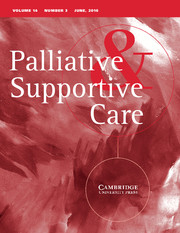Editorial
It's a struggle: That's the nature of life
-
- Published online by Cambridge University Press:
- 23 May 2016, pp. 175-176
-
- Article
-
- You have access
- HTML
- Export citation
Original Articles
Two worlds: Adolescents' strategies for managing life with a parent in hospice
-
- Published online by Cambridge University Press:
- 01 July 2015, pp. 177-186
-
- Article
- Export citation
Parenting in the face of childhood life-threatening conditions: The ordinary in the context of the extraordinary
-
- Published online by Cambridge University Press:
- 14 October 2015, pp. 187-198
-
- Article
- Export citation
Perceptions of the working alliance among medical staff and cancer patients
-
- Published online by Cambridge University Press:
- 19 June 2015, pp. 199-203
-
- Article
- Export citation
Cancer patients' emotional distress, coping styles and perception of doctor-patient interaction in European cancer settings*
-
- Published online by Cambridge University Press:
- 09 July 2015, pp. 204-211
-
- Article
- Export citation
Enabling sense-making for patients receiving outpatient palliative treatment: A participatory action research driven model for person-centered communication
-
- Published online by Cambridge University Press:
- 03 August 2015, pp. 212-224
-
- Article
- Export citation
“It's not about treatment, it's how to improve your life”: The lived experience of occupational therapy in palliative care
-
- Published online by Cambridge University Press:
- 15 June 2015, pp. 225-231
-
- Article
- Export citation
An examination of the research priorities for a hospice service in New Zealand: A Delphi study
-
- Published online by Cambridge University Press:
- 16 June 2015, pp. 232-240
-
- Article
- Export citation
How did partners experience cancer patients' participation in a phase I study? An observational study after a patient's death
-
- Published online by Cambridge University Press:
- 17 December 2015, pp. 241-249
-
- Article
- Export citation
Psyche at the end of life: Psychiatric symptoms are prevalent in patients admitted to a palliative care unit
-
- Published online by Cambridge University Press:
- 08 October 2015, pp. 250-258
-
- Article
- Export citation
The positioning of palliative care in acute care: A multiperspective qualitative study in the context of metastatic melanoma
-
- Published online by Cambridge University Press:
- 12 October 2015, pp. 259-268
-
- Article
- Export citation
Anxiety and depression in patients after surgery for head and neck cancer in Japan
-
- Published online by Cambridge University Press:
- 06 October 2015, pp. 269-277
-
- Article
- Export citation
Assessment of discomfort in patients with cognitive failure in palliative care*
-
- Published online by Cambridge University Press:
- 03 August 2015, pp. 278-283
-
- Article
- Export citation
Review Article
Using a supportive care framework to understand and improve palliative care among cancer patients in Africa
-
- Published online by Cambridge University Press:
- 15 June 2015, pp. 284-301
-
- Article
- Export citation
Case Reports
Early detection and successful treatment of Wernicke encephalopathy in a patient with advanced carcinoma of the external genitalia during chemotherapy
-
- Published online by Cambridge University Press:
- 11 December 2015, pp. 302-306
-
- Article
- Export citation
Terminal delirium misdiagnosed as major psychiatric disorder: Palliative care in a psychiatric inpatient unit
-
- Published online by Cambridge University Press:
- 22 October 2015, pp. 307-310
-
- Article
- Export citation
Essay/Personal Reflections
The Surrogate Daughter
-
- Published online by Cambridge University Press:
- 04 May 2015, pp. 311-313
-
- Article
- Export citation
Personal reflections on the communication skills during clinical clerkships. A challenge for students and professors: Not only for oncology's courses
-
- Published online by Cambridge University Press:
- 19 May 2015, pp. 314-315
-
- Article
- Export citation
Poetry/Fiction
Buttonhook
-
- Published online by Cambridge University Press:
- 23 November 2015, p. 316
-
- Article
- Export citation
Front Cover (OFC, IFC) and matter
PAX volume 14 issue 3 Cover and Front matter
-
- Published online by Cambridge University Press:
- 23 May 2016, pp. f1-f2
-
- Article
-
- You have access
- Export citation



